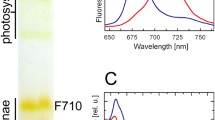Abstract
Siphonous green algae, a type of deep-sea green algae, appear olive drab and utilize blue–green light for photosynthesis. A siphonous green alga, Codium (C.) intricatum, was isolated from Okinawa prefecture in Japan, and a clonal algal culture in filamentous form was established. The major light-harvesting antenna was analogous to the trimeric LHCII found in higher plants, but the C. intricatum complex contained an unusual carbonyl carotenoid siphonaxanthin. Culture conditions were optimized to achieve high siphonaxanthin content in intact lyophilized filamentous bodies. Interestingly, the carotenoid composition was different when cultured under high irradiance: all-trans neoxanthin was accumulated in addition to the normal 9′-cis form in whole cell extract. Resonance Raman spectra of intact filamentous bodies, cultured under high- and low-light conditions, confirmed the accumulation of all-trans neoxanthin under high irradiance conditions. A plausible function of the presence of all-trans neoxanthin will be discussed in relation to the regulation against high light stress.






Similar content being viewed by others

Abbreviations
- C:
-
Codium
- Sx:
-
Siphonaxanthin
- Sn:
-
Siphonaxanthin ester
- tNx:
-
All-trans neoxanthin
- 9cNx:
-
9′-cis neoxanthin
- Vx:
-
Violaxanthin
- Chl:
-
Chlorophyll
References
Anderson JM (1983) Chlorophyll-protein complexes of a Codium species, including a light-harvesting siphonaxanthin–chlorophyll a/b–protein complex, an evolution relic of some chlorophyta. Biochim Biophys Acta 724:370–380
Andreeva A, Stoitchkova K, Busheva M, Apostolova E, Várkonyi Z, Garab G (2004) Resonance Raman spectroscopy of xanthophylls in pigment mutant thylakoid membranes of pea. Biopolymers 74:87–91
Aruga Y, Inoue I, Tanaka J, Yokohama Y, Yoshida T (2000) In: Aruga Y, Inoue I, Tanaka J, Yokohama Y, Yoshida T (eds) Soruigaku Enshu Jisshu. Kodansha, Tokyo, pp 166–167
Chu ZX, Anderson JM (1985) Isolation and characterization of a siphonaxanthin-chlorophyll a/b protein complex of photosystem I from a Codium species (Siphonales). Biochim Biophys Acta 806:154–160
Jeffrey SW, Mantoura RFC, Bjørnland T (1997, 2005) Data for the identificaton of 47 key phytoplankton pigments. In: Jeffrey SW, Mantoura RFC, Wright SW (eds), Phytoplankton pigments in oceanography guidelines to modern methods, UNESCO, Spain, pp 449–559
Koyama Y, Fujii R (1999) In: Frank HA, Young J, Britton G, Cogdell RJ (eds) The photochemistry of carotenoids. Kluwer Academic Publishers, Dordrecht, pp 161–187
Mendes-Pinto MM, Sansiaume E, Hashimoto H, Pascal AA, Gall A, Robert B (2013) Electronic absorption and ground state structure of carotenoid molecules. J Phys Chem B 1117:11015–11021
Oka N, Kusumoto T, Taira T, Iha M, Shigematsu Y, Fujii R, Hashimoto H (2012) Novel mass production of siphonaxanthin from a green alga, “Motsure-miru” (Codium intricatum). Carotenoid Sci 17:19–22
Premvardhan L, Bordes L, Beer A, Büchel C, Robert B (2009) Carotenoid structures and environments in trimeric and oligomeric fucoxanthin chlorophyll a/c 2 proteins from resonance raman spectroscopy. J Phys Chem B 113:12565–12574
Robert B (2009) Resonance Raman spectroscopy. Photosynth Res 101:147–155
Ruban AV, Pascal AA, Robert B (2000) Xantphylls of the major photosynthetic light-harvesting complex of plants: identification, conformation and dynamics. FEBS Lett 477:181–185
Ruban AV, Pascal AA, Robert B, Horton P (2001) Configuration and dynamics of xantophylls in light-harvesting higher plants. J Biol Chem 276:24862–24870
Ruban AV, Berera R, Ilioaia C, van Stokkum IHM, Kennis JTM, Pascal AA, van Amerongen H, Robert B, Horton P, van Grondelle R (2007) Identification of a mechanism of photoproactive energy dissipation in higher plants. Nature 450:575–579
Snyder AM, Clark BM, Robert B, Ruban AV, Bungard RA (2004) Carotenoid specificity of light-harvesting complex II binding sites. J Biol Chem 279:5162–5168
Takaichi S, Mimuro M (1998) Distribution and geometric isomerism of neoxanthin in oxygenic phototrophs: 9′-cis, a sole molecular form. Plant Cell Physiol 39:968–977
Wang W, Qin X, Sang M, Chen D, Wang K, Lin R, Lu C, Shen JR, Kuang T (2013) Spectral and functional studies on siphonaxanthin-type light-harvesting complex of photosystem II from Bryopsis corticulans. Photosynth Res 117:267–279
Yokohama Y (1983) A xanthophyll characteristic of deep-water green algae lacking siphonaxanthin. Botanica Marina 26(2):45–48
Acknowledgments
This work was supported by Japan Society for the Promotion of Science (JSPS) KAKENHI Grant-in-Aid for JSPS fellows Numbers 254,691 to CU. This work was also supported by a Japan Science and Technology Agency (JST), Precursory Research for Embryonic Science and Technology (PRESTO) grant to RF. This work was partially supported by a Scientific Research on Innovative Areas “All Nippon Artificial Photosynthesis Project for Living Earth (AnApple)” Grant (No. 24107002) from the JSPS to HH. HH also thanks the Human Frontier Science Program for financial support.
Author information
Authors and Affiliations
Corresponding author
Rights and permissions
About this article
Cite this article
Uragami, C., Galzerano, D., Gall, A. et al. Light-dependent conformational change of neoxanthin in a siphonous green alga, Codium intricatum, revealed by Raman spectroscopy. Photosynth Res 121, 69–77 (2014). https://doi.org/10.1007/s11120-014-0011-y
Received:
Accepted:
Published:
Issue Date:
DOI: https://doi.org/10.1007/s11120-014-0011-y



